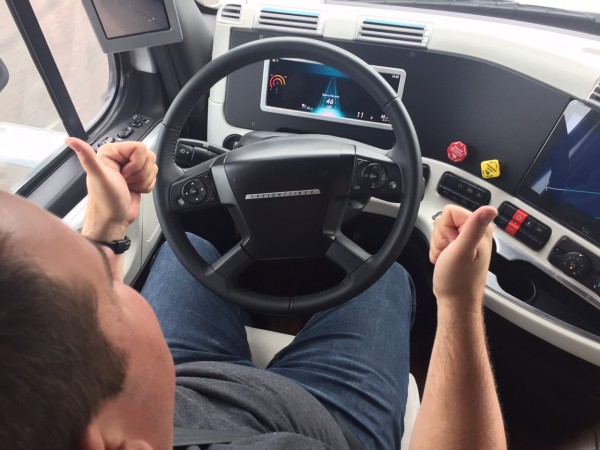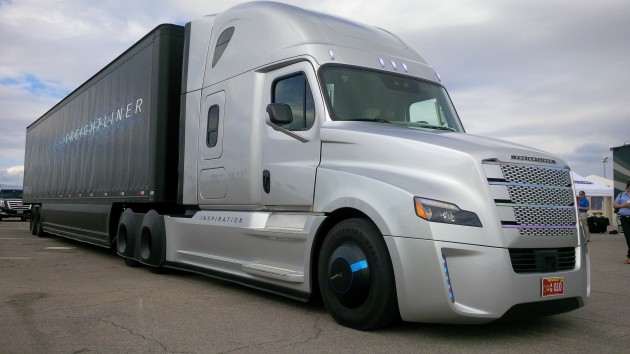Driving the Freightliner Inspiration autonomous truck
LAS VEGAS, Nev. — “No one has ever passed our test.” Not the words you want to hear when you’re about to take that test. The speaker was Jim Martin, one of the few Daimler Trucks North America (DTNA) engineers certified to drive autonomous trucks in the state of Nevada and also licensed to provide certification to other CDL holders.
But while his warning may have quickened the pulse of the handful of North American trucking journalists preparing to obtain the certification, myself included, Martin quickly added, “The reason for this is, this is our first time (giving the test).”
CDL-holders require special certification to operate autonomous trucks in the state of Nevada. The criteria for this certification is developed by the truck maker and then approved by the state. It’s up to the OEM to test individuals wishing to obtain their certification and to issue the certificate allowing them to operate such vehicles.

There’s obvious irony at work here: A special certification is required to operate a truck that can effectively drive itself. But the objective of the training and subsequent certification is to ensure the driver understands how to use the system and more importantly, that they realize they are responsible for the vehicle at all times – even when Highway Pilot is active.
Operating Highway Pilot is not at all difficult.
When Highway Pilot becomes available on the Freightliner Inspiration Truck, a ‘Highway Pilot Available’ notification appears in the driver display. The driver can then click the Set button the steering wheel to activate the system, as long as the engine brake is turned off. The driver can then toggle through to the desired top speed. The engine brake can be activated once Highway Pilot has been enabled. To deactivate Highway Pilot, the driver simply needs to tap the service brake or press the Off button on the steering wheel.
When Highway Pilot is activated, the truck drives itself. It maintains a safe following distance from the vehicle in front of it and adjusts the steering wheel to stay centered in its lane of travel. The gas and brakes are applied as needed – all without human intervention. It’s unsettling at first – especially when traffic is approaching – but I very quickly came to trust the system.
It was a windy day in Las Vegas, with the types of gusting crosswinds that make for tiring driving. It was nice to relinquish control to Highway Pilot and relax while it took care of the frequent steering inputs needed to counteract the wind.
But you won’t be taking the opportunity to climb into the bunk for a nap or fixing yourself a sandwich. The driver is required to always be alert and ready to take over from Highway Pilot when required.
This attentiveness is one of the things Martin and other certifying engineers are looking for during their evaluations.
“As the driver, you need to be totally aware and completely responsible for the operation of the vehicle,” Martin explained before we hit the highway. “Even if Highway Pilot is working and functioning, you still are the driver and you’re still responsible. It’s important to stay facing forward – you don’t want to turn around, don’t get out of the seat, don’t play on your phone – you still need to be aware. This is meant to be an enhancement to the driver. On a day like this, where its windy, if you’re driving manually you are constantly fighting the wind. In Highway Pilot mode, you can let go and let the system fight the wind and that’s a huge advantage when it comes to fatique.”
Among the requirements that must be demonstrated by the trainee during the certification process are the following:
- • Participates in the training of the system and understands the technology;
- • Prior to operating the system, demonstrates knowledge of system capabilities and limitations;
- • Demonstrates ability to operate the vehicle in both normal driving and autonomous modes;
- • Driver must know when Highway Pilot is available, how to enable Highway Pilot and how to disable Highway Pilot and take back manual control;
- • Must demonstrate the ability to react to a system error (induced by a DTNA engineer);
- • Driver reaction time must be less than half a second;
- • A vehicle trajectory error must be corrected in no more than 2.5 seconds;
- • And lane deviation must be corrected to no more than 60 centimetres.
The Highway Pilot system itself is extremely intuitive. And while the concept of autonomous vehicles may initially seem futuristic or far-fetched, in reality the Highway Pilot system simply brings together many active safety systems already in use today through Detroit Assurance. There is nothing new about adaptive cruise control or lane departure warning systems.

Those are the foundations on which the Highway Pilot system is built, with the addition of automated steering. The Highway Pilot’s individual parts consist of: a stereo camera; HMI display; powertrain ECU; radar sensors; braking system; steering gear box; and mirror cameras. The front stereo camera provides a 45-degree view with a range of 328 feet. The long-range radar provides an 18-degree view 820 feet up the road while the short-range radar gives a wider 130-degree view, 230 feet out from the truck. This trio of sensors is what’s used on Daimler’s Detroit Assurance suite of safety systems today.
Daimler officials emphasized that Highway Pilot is intended not to replace drivers, but to enhance their capabilities and to improve safety. It’s a safety system, really, and any payback generated for customers if and when it goes into commercial production will have to be achieved on the merits of safety, not eliminating drivers.
The Freightliner Inspiration truck itself is not currently undergoing validation testing, according to Diane Hames, general manager, marketing and strategy with DTNA.
“It was intended as a demonstration of technology,” she said. “We’re not putting it through a validation cycle. It’s not a prototype truck, it’s a demonstration concept vehicle and the intent was to show what’s possible with the combination of these technological elements.”
Have your say
This is a moderated forum. Comments will no longer be published unless they are accompanied by a first and last name and a verifiable email address. (Today's Trucking will not publish or share the email address.) Profane language and content deemed to be libelous, racist, or threatening in nature will not be published under any circumstances.
James: On the serious side of things, what do you do with your arms, can you rest them on the steering wheel?
This has always puzzled me since I read about this new system. I was told if you touch the steering wheel it will deactivate the system. The law states you must have your two hands on the steering wheel at all times.
Regards, Murray
Concern of mine is what this will do long term to wages, this will limit the training needed for future truckers, making this a minimum wage style job
I would like to purchase one were is the location


“[…]Highway Pilot is intended not to replace drivers, but to enhance their capabilities and to improve safety.” I call bull on this one. Companies would love nothing better than to get rid of their most costly aspect; driver pay. Give it 15 or 20 years and I think, sadly, that the commercial driver will be just about obsolete. A shame that’s where it’s headed, because I’m a young guy just getting into the industry.